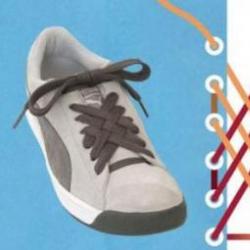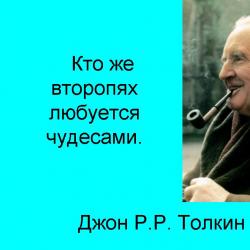Presentation on the topic Lord of the Rings in English. "Welcome to Middle-earth!" Literature lesson based on the fairy tale story by J.R. Tolkien “The Hobbit, or There and Back Again” (5th grade). Domestic literary scholars about “The Lord of the Rings”
"Welcome to Middle-earth!"
Literature lesson onfairy tale by J.R.R. Tolkien
"The Hobbit, or There and Back Again"
(5th grade)
Anokhina S.V.,
teacher of Russian language and literature
MBOU Secondary School No. 17 Reftinsky
Lesson Objectives:
educational- arouse interest in the personality of J.R.R. Tolkien, determine the level of students’ perception of the work they read, introduce them to a special emotional world, create a “presence effect,” and cultivate a sense of beauty;
developing– development of imagination and memory, formation of interpersonal communication skills;
educational improving reading skills; introducing students to individual facts of the writer’s biography, stimulating students’ independence in finding answers to questions posed on the topic.
Lesson type: a lesson in literature using interdisciplinary connections (English and music).
Types of educational activities: student performance, expressive reading of passages, independent work.
Equipment: map of a magical land, audio recordings, an exhibition of Tolkien’s books, Russian and English names of fairy-tale creatures on the board, drawings, computer presentations.
*class includes 2 lessons
Epigraph to the lesson:
“...At my core, I am a hobbit (in everything except size). I love gardens, trees, a rural landscape not disfigured by cars, I smoke a pipe, I adore simple hearty food... I am crazy about mushrooms, my humor is simple, I go to bed early and get up late. And I don’t travel much..." J.R.R. Tolkien
During the classes
1. Organizational moment.
2. Introductory speech by the teacher. (1 presentation slide)
Teacher: Tolkien is the most popular English writer. His books are read all over the world, and after the release of the film trilogy “The Lord of the Rings,” interest in the writer’s work increased. The beginning of the numerous adventures of his heroes was the small fairy tale “The Hobbit, or There and Back Again.” You recently read this fairy tale and let’s look at the history of its creation and discover the secret of its popularity.
Working with a writer's biography
Individual student message. Sample text.
Tolkien was born in Africa. The name given to him at birth sounded luxurious: John Ronald Ruel. There is little left in my childhood memory of South Africa: I was bitten by a tarantula, snakes live in a barn and little ones can’t go there, monkeys jump along the fence, jackals howl at night and lions roar. Perhaps nothing more. From the Orange Republic they moved to England. His father died suddenly when the future writer was 4 years old. When he was 12 years old, he lost his mother. At the age of 18, Tolkien became a scholarship holder at Oxford University (scholarships then, unlike our current universities, were given only to those students who passed the entrance exams not just with an “A”, but brilliantly). At the age of 21 he got married, and two months after the wedding he volunteered for the front. The First World War was going on. Tolkien spent 4 months on the front line in the midst of the bloodiest battle: he walked or crawled under fire through the mud and over dead bodies, side by side with others, and the soldiers considered him one of their own. Then - typhus. This was the end of the troubles in Tolkien's life. The remaining half century passed quietly. He became a respected professor, an expert in many languages, and a brilliant specialist in the Middle Ages. In his family life, Tolkien was a homebody, a loving husband and father. But in literature, Tolkien earned the title of one of the most read authors of the second half of the twentieth century.
Back forward
Attention! Slide previews are for informational purposes only and may not represent all the features of the presentation. If you are interested in this work, please download the full version.
Goals and objectives:
Tell students about your favorite book and make them fall in love with the process of reading as a most interesting process of intellectual work;
Develop students’ imagination based on the text chosen by the teacher;
Train in working with text, selecting text material and analyzing it;
Imbued with the beauty of Tolkien's words;
Preparatory stage.
1. Watching a movie.
2. Presentation for the lesson.
3. Individual creative tasks.
Who in a hurry admires miracles?
John R.R. Tolkien(slide 2)
During the classes
1. In the magical land of John Tolkien. (Slide 3)
Come quickly! Well, we'll sing for you
About dew, streams and rivers, about cheerful rains,
About the steppes, where there is dry land and heather, about mountains and valleys,
About the high summer sky and forest lakes,
About drops from spring branches, winters and frosts,
About sunsets and sunrises, about the moon and stars -
We will sing a song about everything in the world together!
Tolkien was a professional linguist and knew several foreign languages. He felt the word and its sound very subtly. The “Lord of the Rings” trilogy immediately captivated me with its uniqueness - its fairy-tale plot, amazing heroes gathered to fight the Mist, the beauty of the word, its precision, musicality, accuracy, imagery and brightness of epithets and comparisons.
Rain: glass silver; pearl-silver; silver curtain of rain.
“The shimmering curtain flowed like a silky, pearl-silver canopy, a drop of moonlight.”
Water: glassy; splash of falling water; silver stream river.
Grass and flowers: silky grass; the honey smell of flowers and herbs; grass silvered with dewdrops; surprised flowers.
Stars: Starred. The sky bloomed with stars. Star Light; the shine of the stars; iridescent stars.
Crystal morning.
Days and nights: “Calmly bright, like drops of dew, sparkled clear days.” “It was September: the days were golden, the nights were silver.”
Light: “The ancient put two stone bowls on the table, probably with water,... and one glowed with gold, the other... with dark green light. The peace was illuminated, green-golden reflections ran along the walls......the trees began to glow,...and...every leaf was dressed in a halo of green, gold, copper-red, and the trunks seemed like columns sculpted from transparent stone.”
Tolkien's heroes are enchanted...Frodo is enchanted by the magical shine and magical magnetism of the golden ring, Aragorn-the beauty of Arwen and his future city of Gondor, Legolas-the elven kingdom of Cvetlorien, Gimli-the stone flower garden of the caves, Sam-the beauty of Galadriel, Pin and Merry-native Hobbitania, “where the summer is lush, the autumn is fruitful... The branches were bursting with apples, the honeycombs were dripping with honey, and the wheat was raising its tight ears.” The ancient admires and admires his beloved rowan trees:
My rowan trees are elegant, proud trees!
My beloved rowan trees, oh, how can I call you?
The spring color enveloped you like a silver blanket,
Wearing bright green attire, you greeted the summer dawn.
I heard your welcoming, gentle voices.
The rowan beauty was crowned with red clusters.
And they are all enchanted by the beauty of the forests, fields, flowers, the names of the fast-flowing rivers: Zolotinka, Serebryanka, Bystrogrivka, Vorozheya, Snegovaya, Zerkalnoye Lake.
And I am enchanted by the music of Tolkien’s words, prose, into which poetic text is superbly woven: poems, ballads, songs and tales.
(slide 4) Our path for miracles is illuminated by the elven star-phial of Galadriel. The Magic Mirror of Galadriel - “a silver bowl on a low pedestal of white marble” - gathered around it the heroes of John Tolkien’s “The Lord of the Rings” trilogy.
I don’t know what exactly the Mirror will show you - the past that determined your current life, or some current events that could affect your destiny, or what may happen in the future...
Look...
2. In search of a miracle. The Magic Mirror of Galadriel.
(Slide 5) The mystery of the ring. Gandalf.
Three Rings - for the royal elves in the heavenly tents,
Seven - for the powerful gnomes, lapidaries in the womb of stone,
Nine is for the Nine, clothed in the dust of the grave.
The Lord on the black throne will wear one
One Ring will conquer them, one will gather them,
One thing will attract them and bind them into a black chain
In a land called Mordor, where darkness spreads.
We are not given the opportunity to choose our fate; however, this time we have been given time, and the main thing is not to miss it... The enemy is very strong, but in order to break all resistance... and flood Middle-earth with Darkness, he lacks one thing - the One Ring. The elves hid the three most beautiful Rings from him... The dwarves had the Seven Rings; He obtained three, the rest were destroyed by dragons. He distributed nine to the majestic and proud people in order to enslave them. Long ago, long ago, they turned into ring-bearers - ghosts, into Servants of Darkness... ...There is only one way: ...throw the Ring into... the flaming depths... so that it melts and becomes forever inaccessible to the Enemy.
(Slide 6) Who did Gandalf see in the Mirror of Galadriel? Frodo.
But even if it’s not me, even if it’s someone else, am I capable of such feats?
There is no strength in you, no wisdom. However, you are chosen, which means you will have to become strong, wise and valiant.
Curse of Isildur. Frodo.
Elendil broke his faithful sword,
In battle, not sparing yourself,
And Isildur won in that battle
A curse to yourself.
But in Imladris they will forge again
Broken Chief's Sword,
And the short one dares to take
Curse yourself.
(Slide 7) Who did Frodo see in Galadriel's Mirror? Frodo saw Strider.
Return of the King. Aragorn.
Ancient gold rarely shines
The ancient blade is fierce.
The ranger king will go out to battle:
Mature does not mean old.
Troubles will become overgrown with reality,
The blade will flash again
And the king will be called king -
In honor of another king.
On... the earth (Lorien) there is no place for Evil: it dies even in the thoughts of evildoers if they bring it with them...
(Slide 8) Who did Aragorn see in Galadriel's Mirror? Aragorn saw the Maid of Rivendell - Arwen.
Arwen: In the twilight North, shine, Elven Beryl!
Call your friends to arms and gather your relatives.
They will see, hear - and everyone who is alive will respond -
And the Gray Squad will come out to the southern borders.
You are destined for lonely and exorbitant work:
The dead guard the direct road to the Sea.
Every hour counts. Either our hopes will come true, or all hopes will end.
...Farewell until better times, Elven Beryl!
(Slide 9) Elven Prince Legolas.
Lightning of the all-night dawn
Beyond the distant seas.
Burn with eternal hope
Over our mountains!
O Elbereth! Giltoniel!
The light of hope is far away!
From our shadowy lands
I bow to you deeply!
You overcame the evil darkness
On a black sky
And lit the clear stars
In your night crown.
Giltoniel! O Elbereth!
Shine in the blue temple!
We remember your eternal light
Beyond the distant seas!
What did Legolas see in Galadriel's Mirror?
-...The silver trees of Kvetlorien...do not lose their thick foliage in the fall: it becomes bright golden and stays on the branches until the arrival of spring. In the spring, last year's leaves fall, covering the forest glades with gold, and on the branches, along with new leaves, golden-yellow flowers bloom, filling the air with a honey fragrance...
“The wind tears golden leaves from countless, like years, golden branches. Long, long years passed like honeyed freshness over the meadows of the Seaside, and the stars fluttered in the blue skies over the bright pass.”
(Slides 10, 11) The Lady of Lorien is Galadriel. Sam.
Well, she’s beautiful...! You can't stop looking at it! Sometimes...she’s like a slender tree in bloom, and sometimes like a little white amaryllis...Flint...and softer than moonlight. Warmer than the sun, but cold - like frost on a starry night! Proud, majestic - purely a mountain in the snow, and cheerful, like a girl in a daisy wreath.
(Slide 12) And you, Gimli, what did you see in the Mirror of Galadriel?
Stone flower garden.
A marvelous wonder... These are huge palaces in which the slow music of iridescent streams and eternal drops over the lakes sounds and sounds... ...smooth walls sparkle with a mysterious light, marble lace and curls like shells, transparent, like the metacarpus of the Lady Galadriel. ... everywhere rise up and grow from the multi-colored floor, fanciful, like dreams, twisted sculptures of columns - snow-white, yellow-brown, pearl-pink, and above them stalactites shine - wings, garlands, curtains, petrified clouds; towers and spiers, weather vanes and banners of hanging palaces, reflected in motionless, frozen lakes... Caves! Mansions...
(Slide 13) Home. Hobbits. Pin and Merry.
So our fairy tale ends!
Hobbits...
There the sun pours its rays
To the spring gardens,
The meadows are blooming, the streams are babbling,
Blackbirds sing in the gardens.
Or maybe the starlight is shining
And I would have seen
How quietly it glows in the foliage
Pearl Star.
“In the Common Meadow, a young tree of wondrous beauty, with silver bark and elongated leaves, did not grow, but burst out of the ground; by April it was covered with golden flowers.
...it was mallorn...
The year 1420 was fabulously fine: the sun was shining tenderly, the rains were flowing softly, on time and generously, and besides, the air was honey-like, and there was a quiet reflection of... beauty on everything. ...All the children born ... that year ... were strong and handsome to choose from ... Everything was born abundantly ... ... No one was sick, everyone was cheerful and happy ... "
What did Pin and Merry see in Galadriel's Mirror? A ship sailing to another world.
(Slide 14) Silver Harbor.
A ship, a gray-winged ship!
Do you hear distant calls,
Those who sailed away before me
conscription votes?
Farewell, farewell, my dense forests,
Days on earth have dried up, and centuries begin again...
“Frodo... came on board. The sails were raised, the wind blew; the ship moved slowly along the long bay. The clear light of Galadriel's phial, which Frodo held in his raised hand, became a faint flicker and was lost in the darkness. The ship went out to the open sea...”
Perhaps not in a dream at all
A door will appear in a blank wall
And will dissolve before me, .
Revealing a different world.
And someday a moonbeam
Like a secret sign will show the way
3. Questions for the class.
Which characters would you like to see in The Mirror of Galadriel?
(Slide 15) The class unanimously chose Gollum.
Three Rings - to the wise elves - for their proud good,
Seven Rings - to cave gnomes - for their mountain work
Nine - to the people of Middle-earth - for the service of the wise
And fearlessness in battles is deadly strong.
And One - omnipotent - to the Lord of Mordor,
To separate them all, to deprive them of their will
And unite forever in their earthly vale
Under the dominion of the all-powerful Lord of Mordor.
The ring, which was supposed to belong to the Lord of Mordor and multiply evil, Gollum tenderly and lovingly called: “Lovely!” In this one word is the love story of a hobbit who did anything: murder, humiliation, suffering, torture, hunger, betrayal, transformation from a hobbit into a terrible freak. He walked a difficult path from Mordor and to Mordor and died to be with his love, bravely throwing himself into the bubbling flames after his Charm.
Gandalf was right when he predicted that “a traitor...will unwittingly do a good deed.” For the suffering he endured, he deserves leniency and pity, because not everyone can love like that.
What would you guys like to see in the Mirror of Galadriel? (This work is homework)
(Slide 16) I am very glad that the fantasy world created by Tolkien fell in love with you, became near and dear to you, and my favorite book became your favorite book.
I thank you for participating in this lesson.
Bibliography
- Tolkien. J. The Lord of the Rings [Text] / Tolkien J. – Any edition.
History of creationTolkien did not initially intend to
write a sequel to
"The Hobbit" (which actually
is the novel "Lord"
rings"). However, on November 15, 1937,
lunch time with the owner
publishing house that published
"The Hobbit" by Stanley Unwin
received an offer to present for
consideration of other works.
Publisher's reviewer rejected
directed by The Silmarillion, although
spoke about him
positive.Encouraged by this
Tolkien began writing a sequel
"The Hobbit" and already on December 16, 1937
in a letter to the publisher reported the first
chapter of the new book.
Target
Tolkien's goal was to create Englishepic Tolkien produced a heavy
impression of the First World War, as well as
industrialization of England, according to him
opinion, which destroyed the England that he
knew and loved. That's why Lord of the Rings
passeism (longing for the past) is inherent.
Tolkien was Oxford
philologist, well acquainted with
medieval myths of Northern Europe,
such as “The Saga of Hervarar”, “The Saga of
Velsungah", "Beowulf", as well as with others
Old Norse, Old English and
medieval English texts.
"The Lord of the Rings" was inspired by and
other literary sources
for example, legends of the Arthurian cycle and
Finnish epic "Kalevala".
English epic
The creation of English epics is oftendiscussed at Tolkien's meetings with
Inklings (literary
discussion group at Oxford
university, at weekly
meetings of this group discussed
Icelandic myths and their own
unpublished works). Tolkien
agreed with one of the members of this
group, Clive Lewis, that in
absence of English epic
you need to create it yourself.
Theme of the book
In parallel with these discussions, in December 1937, Tolkien began"new hobbit"After several unsuccessful attempts, the story began
gain momentum, from a simple continuation of “The Hobbit” turning
rather in continuation of the unpublished
"The Silmarillion". The idea for the first chapter arose immediately in the finished
form, although the reasons for Bilbo's disappearance, the idea of the importance of the Ring
.All the delights and the title of the novel became clear only in the spring of 1938
years.At first Tolkien wanted to write another story in which
Bilbo, having spent all his treasures, set out on new ones.
adventure, but, remembering the ring and its power, decided instead
write about him. In the beginning, the main character was Bilbo, but then the author
decided that the story was too serious for such a comical and
cheerful character. Tolkien considered sending
Bilbo's son's journey, but questions arose: Where was his wife?
How did Bilbo let his son go on such a dangerous journey? Eventually
Tolkien decided to continue the tradition of ancient Greek legends, in
of which: an artifact possessing magical powers receives
nephew of the main character. This is how the Hobbit Frodo Baggins came into being.
Process of creation
Tolkien wrote slowly.literary work often
interrupted by academic
duties, in particular Tolkien
had to take an exam
students (even the first phrase
"The Hobbit" was written in pure
exam paper page
one of the students). During 1943
Tolkien did not work on the text for years, but
continued work in April 1944. Chapters
from the novel Tolkien sent to his son
Christopher, who served in Africa, in
British Air Force and Clive Lewis.B
In 1948 the story was completed, but
continued until 1949
editing of early parts
"The Lord of the Rings".
Difficulties
Due to a shortage of paper inpost-war period
, the publishers asked
break the novel into 6
books that do not have
names.Then for
convenience they were
combined in pairs
publisher at three
parts that were
called "Brotherhood"
rings”, “Two fortresses”,
"Return
king."The three parts were
published in England 29 July
1954, November 11, 1954
years and October 20, 1955
years, and a little later in
USA.
Trilogy
Since then, "The Lord of the Rings" began to be calledtrilogy. Tolkien himself used this term,
although in other cases he said that this was not correct.
The novel was published by various publishers in one,
two, three, six and seven volumes.
Fairytale world of Middle-earth
PeopleElves
Gnomes
Hobbits
Magi
Orcs
Onty
Nazgul
Image of the Ring
Ring image
RING is one of the universal images inTolkien's poetics, bearing enormous
semantic load.
RING - traditional magic
an object that gives the owner
magical abilities: 1.does
the owner is invisible, 2.keeps
youth, 3.gives healing, 4.becomes
a guide to a fairy-tale world.
Rings
Seven - for the rulers of the gnomes, lapidaries instone bosom,
Nine - for the nine clothed with grave clothes
dust,
The ruler on the black throne will wear one, in the country of
named Mordor, where darkness spreads,
One ring will conquer them,
one will gather them,
One thing will attract them and bind them into a black chain, In the country
named Mordor, where darkness spreads.
Tolkien has 20 rings.
One Ring
RINGOmnipotence is the most
mysterious and universal,
uniting all the other rings.
This is a symbol of EVIL and at the same time
the real embodiment of POWER. U
Tolkien's concepts of POWER and EVIL
inseparable. It is with the help of this
fairy-tale-mythological image
Tolkien embodies the idea of the novel.
Image of the Elves
Elves are wisecreatures capable
foresee the future
reincarnate,
understand the language of animals.
Therefore their three rings are not
fell into the hands of Sauron. By
according to the creator's plan, the ring
elves contain
the power of three elements - fire,
air and water.
Image of the Nazgul
The Nazgul are a symbol of the thirst for power, darkness, and ambition. Kings andcommanders most often become slaves of the ring. After
upon receiving the ring their souls turn black. They become
servants of Sauron, thereby thinking that they
some kind of power will fall. Tolkien gives the Nazgul
numerous names and titles: black horsemen,
winged messengers, spearmen, ulairs (from elf - “non-light,
dark").
Orc Image
Orcs - imageenslavement, torment.
Orcs do everything
orders of Sauron.
They are suffering
working in the mines and
in the clearing
trees.
Image of Onts
Onts are a symbol of freedom. Thisliving trees that
monitor the forests. They
slow in speech and
conversations. No one above them
has no power. In that
lies their freedom.
Female Ents were
destroyed by Orcs.
Image of the Magician
Gandalf –powerful
magician and wizard
symbol
justice and
God-giver. IN
their main
features (gray-haired
beard,
wide-brimmed
hat, coat)
corresponds
guise
Scandinavian
god Odin.
Hobbits
Gianni Rodari hasthe term "fantasy binomial"
revealing
creation process
fairy tale image:
REAL + REAL =
WONDERFUL in Tolkien
many images, one of
them - hobbit (from homo man, lat. and rabbit - rabbit,
English). Colliding these two
concepts Tolkien achieves
"miraculous" effect.
Hobbit image
Image of Hobbits Human hobbits inherit traitsrespectable
Englishman
Victorian era:
prefer
measured, calm
existence in a cozy
Hobbits, appreciate
nepotism
Topic: “The fairy-tale narrative of R. Tolkien “The Hobbit, or There and Back Again” (Textbook: Literature 8th grade. Lanin B. A.)
Goal: To characterize the characters of “The Hobbit, or There and Back Again”, to determine the idea and problem posed by the author in the work
Teacher's word. Today our lesson is devoted to a fairy tale written by John Ronald Reuel Tolkien, an English professor of literature, a specialist in medieval folklore and mythology.
The magical country he invented, called Middle-earth, is inhabited by magical creatures: gnomes, elves, goblins, orcs, trolls, wizards, and fairy-tale creatures. In his fairy tale, Tolkien showed us a model of the world, “humanity” with its own history, with peoples speaking different languages, with its own laws and moral values.
What peoples inhabit Middle-earth, and how does the author describe them?
Dwarves are small creatures endowed with supernatural powers, living in the depths of the earth and storing their treasures there. They are skilled artisans and know how to forge magic rings and swords.
Elves are spirits of the air who live in trees and have the gift of healing and clairvoyance. Their magical music enchants even inanimate nature. Skillful and fearless warriors. They speak the Elvish language, Sindarin.
Hobbits are a small people living in “holes”, peaceful and hospitable, lovers of good food and smoking a pipe. They have large, brown fur-covered feet with leather soles, so they never wear shoes. The main characters of the story “The Hobbit, or There and Back Again” and “The Lord of the Rings” Bilbo Baggins and Frodo Baggins belong to this people.
Goblins are tall, angry and strong creatures that live in underground tunnels. Their homes are full of stolen treasures. They are ugly and cruel.
Trolls are ugly, strong, but stupid cannibal giants who live inside the mountain.
Orcs are creatures created from clay by the wizard Saruman. They are strong and cruel, ugly and soulless.
Who are the main characters of the story?
Bilbo Baggins is a hobbit who went on a long journey to retrieve the dwarven treasure Arkinston.
The wizard Gandalf is an old man with a staff who helps the dwarves.
Thorin Oakenshield is the leader of the dwarves, fearless and fair.
Gollum is a hobbit who has lost his form.
High Goblin.
Dragon Smaug.
What problem does Tolkien raise in his tale?
R. Tolkien raises the eternal problem of Good and Evil in his story.
What is the idea of the work?
Good conquers evil, no matter how hard the struggle is, and no matter what the cost.
Which of the heroes of the story represents the side of Good, and who is on the side of Evil?
Bilbo Baggins, Gandalf, Thorin Oakenshield and the rest of the dwarves perform feats in the name of Good; they are helped by elves, giant eagles, the forest wizard Radagast, and the bear-man Beorn.
On the side of evil are goblins, trolls, orcs.
Describe the characters in “The Hobbit, or There and Back Again”
Bilbo Baggins is a friendly, homely hobbit who loves homeliness and comfort. He is somewhat cowardly and does not want to go on a hike to no one knows where or why. But, having gone on a journey against his will, he changes. It reveals unexpected courage and bravery, ingenuity and resourcefulness of the mind. Bilbo saved the dwarves more than once; he earned the respect and recognition of Thorin Oakenshield, who initially opposed his participation in the campaign. It is he who returns the dwarves their treasures and the priceless Arkinston diamond. Not at all heroic by nature, he turned out to be capable of accomplishing a feat, and not alone.
Gandalf is a wise wizard who took on the difficult mission of leader of the forces of Good in the fight against Evil. With his wisdom, courage and desire to achieve victory even at the cost of his life, Gandalf rightfully becomes one of the most striking characters in the story. It is Gandalf who gathers and unites such controversial heroes.
Thorin Oakenshield is the leader of a detachment of twelve dwarves, heir to the throne of the dwarven kingdom of the Lonely Mountain. Bold, courageous, a true leader who earned the respect and devotion of his subjects with his commitment to the return of the dwarves to the Lonely Mountain, which was captured by the dragon Smaug. At the end of the story, Thorin succumbed to the greed characteristic of dwarves, the greed of possessing countless treasures, but atoned for his guilt by death. It seems to me that he cannot be blamed for this weakness.
Lesson summary: We met the heroes of John Ronald Rowell Tolkien’s story “The Hobbit, or There and Back Again”
We learned about the world of Middle-earth, created by the imagination of the author of the fairy tale, about the peoples inhabiting this world.
We identified the problem and idea of the work.


History of the creation of the novel Tolkien's goal was to create an English epic. The writer was deeply impressed by the First World War, as well as the industrialization of England, which, in his opinion, destroyed the England that he knew and loved. Therefore, The Lord of the Rings is characterized by passeism (longing for the past). The novel began in 1937. Printed in years only. The Lord of the Rings was first translated into Russian in 1976. There are about 7 different translations of the book. The most famous is the translation by V.S. Muravyov and A.A. Kistyakovsky. The book became widely known here in the late 1980s and early 1990s.

Three parts of the novel “The Guardians” (“The Fellowship of the Ring”, “The Fellowship of the Ring”)“The Guardians” (“The Fellowship of the Ring”, “The Commonwealth of the Ring”) “The Two Strongholds” (“The Two Towers”, “The Two Towers”) “The Two Strongholds” (“Two Fortresses”, “Two Towers”) “Return of the Sovereign” (“Return of the King”) “Return of the Sovereign” (“Return of the King”)


The image of the Ring RING is one of the universal images in Tolkien’s poetics, carrying a huge semantic load. A RING is a traditional magic item that gives the owner magical powers: 1. makes the owner invisible, 2. preserves youth, 3. gives healing, 4. becomes a guide to a fairy-tale world.

Rings Three rings - for the royal elves in the heavenly tents, Seven - for the rulers of the dwarves, lapidaries in the womb of stone, Nine - for the nine, clothed in the grave dust, One will be worn by the ruler on the black throne, In the land called Mordor, where darkness spreads, One the ring will conquer them, one will gather them, one will attract them and bind them in a black chain, in a country called Mordor, where darkness spreads. Tolkien has 20 rings.

Ring of Omnipotence RING OF Omnipotence is the most mysterious and universal, uniting all other rings. This is a symbol of EVIL and at the same time the real embodiment of POWER. For Tolkien, the concepts of POWER and EVIL are inseparable. It is with the help of this fairy-tale-mythological image that Tolkien embodies the idea of the novel.


The image of the Nazguls The Nazguls are a symbol of the thirst for power, darkness, and ambition. Kings and generals most often become slaves of the ring. After receiving the ring, their souls turn black. They become servants of Sauron, thereby thinking that some kind of power will fall to them. Tolkien gives the Nazgul numerous names and names: black horsemen, winged messengers, spearmen, ulairs (from elf - “non-light, darkness”).




Hobbits Gianni Rodari has a term “Binomial of Fantasy”, which reveals the essence of the process of creating a fairy-tale image: REAL + REAL = MIRACULOUS Tolkien has many such images, one of them is the hobbit (from homo - man, Latin and rabbit - rabbit, English) . By colliding these two concepts, Tolkien achieves the effect of the “wonderful.”


The problem of the novel The problem of the novel is the opposition of good and evil. Evil is embodied in a ring that gives power over the world and thereby forces one to renounce love. It is no coincidence that the ring is destroyed not by the giant hero, but by the little hobbit - a fairy-tale-fantastic version of the image of a little man, common in the realistic literature of the 19th-20th centuries.







